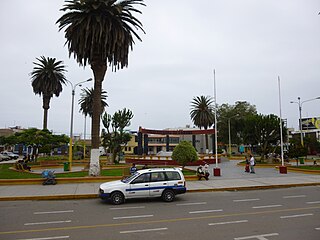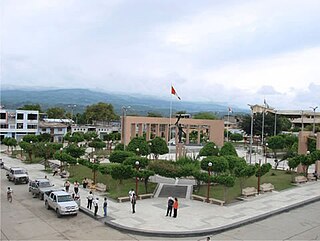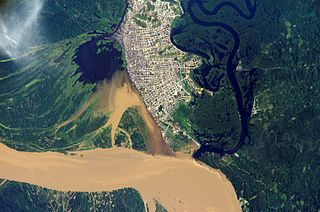
Misiones is a department located in the southern region of Paraguay. Its capital is San Juan Bautista. The eighth of Paraguay's 17 departments, it was created in 1906, then known as the San Ignacio Department, and was not given its present name until 1945. Its current name reflects its status as home to several Jesuit Reductions, or missions.

San Vicente de Cañete, commonly known as San Vicente or Cañete, is a city and capital of the Cañete Province, in southern Lima Region. With a population of 85,533.

Camaná is the district capital of the homonymous province, located in the Department of Arequipa, Peru. In 2015, it had an estimate of 39,026 inhabitants.

This is a list of the 50 largest cities in the Americas by population residing within city limits as of 2015, the most recent year for which official population census results, estimates or short-term projections are available for most of these cities. These figures do not reflect the population of the urban agglomeration or metropolitan area which typically do not coincide with the administrative boundaries of the city. For a list of the latter, see List of metropolitan areas in the Americas by population. These figures refer to mid-2015 populations with the following exceptions:
- Mexican cities, whose figures derive from the 2015 Intercensal Survey conducted by INEGI with a reference date of 15 March 2015;
- Calgary, whose 2015 municipal census had a reference date of April 1.
- Brazilian Cities, whose figures originate from the 2021 estimate given by the IBGE, with a reference date of July 1st, 2021.

Trujillo Province is one of twelve provinces in La Libertad Region in Peru.

Bagua Grande is a town in northern Peru, capital of Utcubamba Province, in the region Amazonas. It has an estimated 42,396 inhabitants, having changed from a rural to an urban area after experiencing much immigration in the 1960s. It is called by their inhabitants Corazón de Amazonas.

Chepén is a city of La Libertad Region and capital of the Chepén Province, in Peru. The city is a rice production center with the valleys of Chepén and Jequetepeque, and has an active trading with neighboring Guadalupe, Pacasmayo and San Pedro de Lloc and other towns. It has factories in industrial dyes, food and primary production.

Moche is a Peruvian city, the capital of Moche District in Trujillo Province of La Libertad Region in northern Peru. It is located in the Moche Valley and was the center of development of the ancient Moche or Mochica culture. Now it is a major tourist destination of the Moche Route tourist circuit and It is part of the integrated area of Trujillo city.

Ilave, also known as Illawi, is the capital city of the Ilave District in El Collao Province, in the Puno Region of Peru. According to the projection of the 2012 census, it has 57,366 inhabitants.
The Arequipa Metropolitan Area is the name used to refer to the metropolitan area whose principal city is Arequipa, according to Metropolitan Development Plan of Arequipa According to population statistics of INEI It is the second most populous metropolitan area of Peru in year 2017.

The Iquitos Metropolitan Area is the name used to refer to the Peruvian metropolitan area whose principal city is Iquitos, according to Municipality of Iquitos. According to population statistics of INEI It is the sixth most populous metropolitan area of Peru in year 2015.










